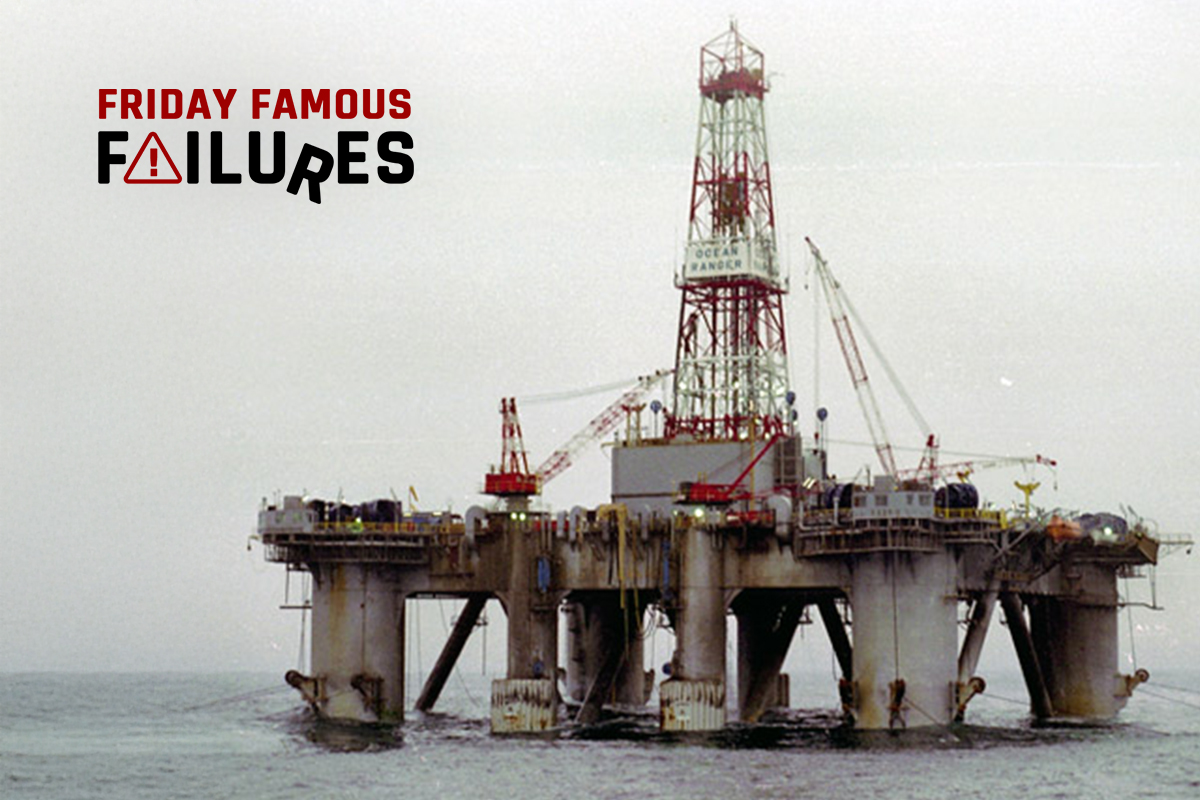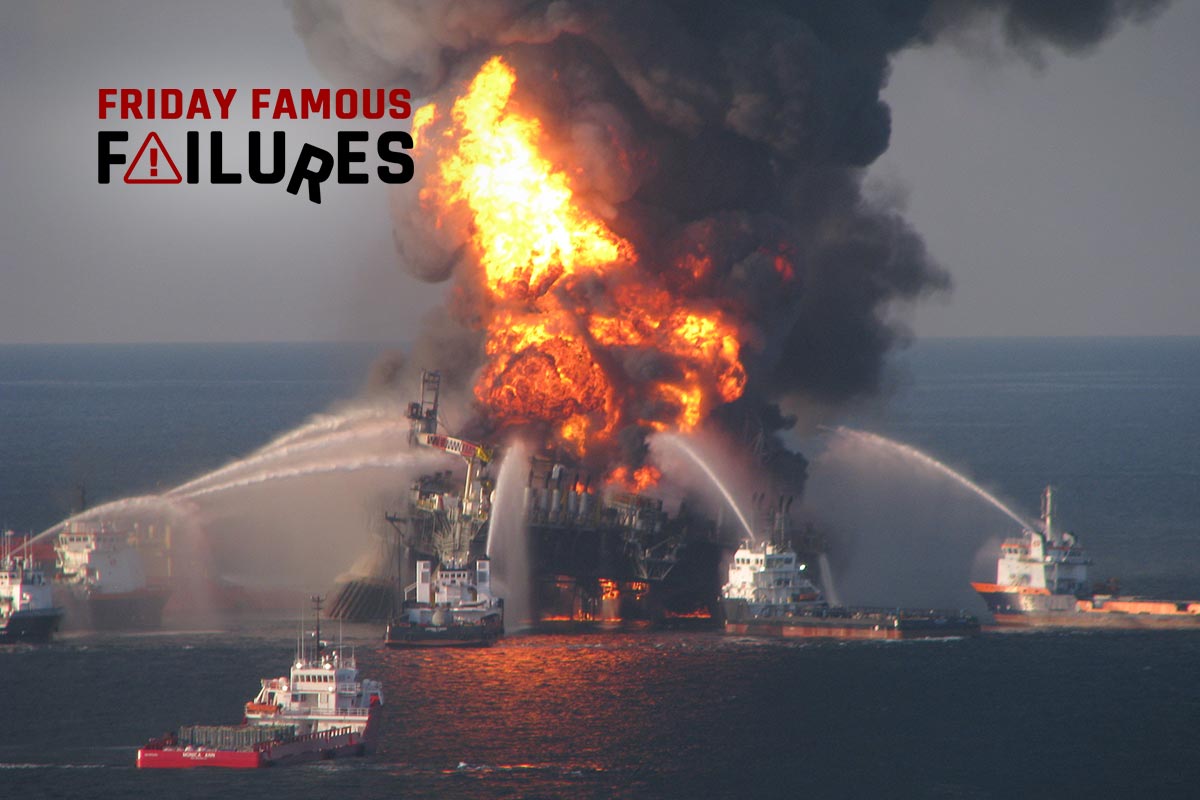On 27 March 1980, the offshore oil platform Alexander Kielland was, as a floating crew accommodation, supporting drilling operations by the Edda 2/C in the North Atlantic. There were 212 off-duty oil platform workers aboard that evening.
The Alexander Kielland was designed as an oil drilling platform by the French shipyard CFEM (Compagnie Francaise d’Enterprises Metalliques), and construction began in the Dunkirk shipyard in 1969. It was delivered to the Norwegian energy company Stavanger in July 1976, whereupon it was converted to a floating accommodation to support other drilling platforms, and its accommodation capacity was increased from 80 to 348.
At 6:29 PM, crewmembers felt a “sharp crack,” then “some… trembling.” The platform suddenly lifted 30 degrees as five of six anchor cables broke, with the single remaining cable preventing the Alexander Kielland from capsizing completely. This cable held until 6:43 PM when it snapped, and the platform turned over in the water. Only five lifeboats had been launched at this time. Of the 212 people aboard at the time, 123 died in the disaster, making it the worst loss of life at sea in Norwegian history since World War II.
What caused this disaster?
Fabrication defect on D-6 brace. The point of failure for the platform was a 6mm fillet weld that joined a non-load-bearing flange plate to the D-6 bracing, which had been poorly applied during the initial build of the platform at a shipyard in Dunkirk, France. The poor profile, or thickness and geometric shape, of the fillet weld, along with cold cracks in the structural steel due to the weld, reduced the fatigue strength of the bracing. Ironically, the flange plate was intended to hold sonar equipment used during drilling operations, and so was entirely extraneous to the Alexander Kielland’s purpose as a floating accommodation.
Lack of Structural Redundancy. Codes for the building of offshore platforms at the time of fabrication and at the time of the disaster had no requirements for structural robustness or damage tolerance. Also, the damage stability requirements in the existing codes did account for the loss of an entire column. Therefore, the structure and design of the Alexander Kielland could withstand the breaking of a brace but was doomed by progressive failure of other braces after the initial failure on the D-6 brace.
Cyclical (environmental) stresses. Although the Alexander Kielland was designed to handle the cyclical stresses of the offshore environment, these stresses caused the cracks present in the D-6 bracing to grow larger over time until, at the time of the disaster, there was less than half the expected steel present. Cyclical stresses include wave motion, applied force from wind, and anchoring and mooring forces on the platform.
Lack of command structure. Between the failure of the D-6 brace and the final capsize of the platform, there were 14 minutes in which crew members could evacuate. However, the subsequent investigation showed that no member of the platform effectively took charge, and the evacuation was slow. Furthermore, the 14 minutes available for evacuation could have been much longer had there been effective damage control, such as closing watertight doors to prevent flooding, but without a command structure, there was no coordinated damage control.
Not enough survival suits. There were not enough survival suits on board for all the crewmembers, so some who did escape died of exposure in the North Atlantic
Lifeboats could not be launched. While there were enough lifeboats for all crewmembers, only one was launched effectively. One of the reasons for this was that the lifeboat hoists could not release the boat if there was tension on the line – a safety measure designed to prevent the lifeboat from being released above the water and falling from the platform. During the disaster, however, five lifeboats were loaded but not released, forcing their occupants to swim for safety or causing them to be drowned by the capsizing platform.
No emergency reaction plan. It took over an hour for the standby vessel, nominally assigned to be on station and to recover survivors in the event of an accident, to reach the scene. In this disaster, the standby vessel did not rescue anyone; all survivors were picked up by existing lifeboats or by rafts thrown by the neighboring platform, the Edda.
Effects of the disaster
After the disaster, an investigation began into the cause of the Alexander Kielland’s collapse and the slow, ineffective evacuation and rescue. Stavanger was able to salvage the platform on the third attempt, raising it from the seabed and bringing it into a dock berth for examination.
The material used in the brace was carbon-magnesium steel with a minimum specified yield strength of 355 newtons per square millimeter. The material was found to still match specification (i.e., there was no degradation of material strength).
At the break in the D-6 brace, however, the investigators found that a fillet weld attaching a flange plate had cracked the original steel due to heat stress when applying the weld. Paint on the crack in the brace proved that it had occurred during fabrication of the platform in Dunkirk – it had propagated around the brace during the life of Alexander Kielland, but it had begun during the platform’s construction. This brace had never been inspected or tested for fatigue, as manuals only required periodic inspection of the columns (not the braces).
As a result of the D-6 brace failure, the five other tubular bracings connecting to one of the vertical columns failed and broke off due to overload, and that column separated from the platform. As a result, the Alexander Kielland became unbalanced and capsized. The only thing that held up the final collapse was the single anchor cable that held for 14 minutes – the disaster would have been much worse if that cable had snapped immediately.
In response to the investigation results, the Norwegian Maritime Directorate made redundancies of stability and structural strength on offshore platforms mandatory and required improved life-saving equipment to be installed on all platforms as well. The International Maritime Organization (IMO) also responded, adding strengthening standards for stability, motion characteristics, maneuverability, watertight doors, and structural strength to their building codes for offshore platforms.
Stavanger and all Norwegian offshore installations, in response to the Alexander Kielland sinking, improved their command organization. Specifically, they identified a clear authority on each vessel to coordinate emergency response and give a final order to abandon ship, if necessary. The improved command structure that was implemented for offshore platforms was similar to conventional shipping command structures, and are today frequently put into use when offshore platforms lose anchorage in storm conditions or when fixed platforms are threatened by out-of-control vessels.
The difficulties encountered by the Alexander Kielland crew in launching lifeboats, due to the misguided safety feature preventing their release from the hoist while tension was on the line, led to new regulations requiring lifeboats on offshore platforms to be deployable, or able to be released, even when there is load or tension on the hoist line. The International Maritime Organization (IMO) also issued a requirement that all lifeboats on merchant ships be fitted with hooks that could be released even when they were under load.









Every advance in standards and codes is written in blood. This is unlikely to ever change as only hindsight is 20/20.
It would be great, in a story like this, to include diagrams and/or photos of the brace causing the problem.
You said it D.J. Even the Civil War – and huge US civilian casualties, caused a big advance in medicine especially surgery.